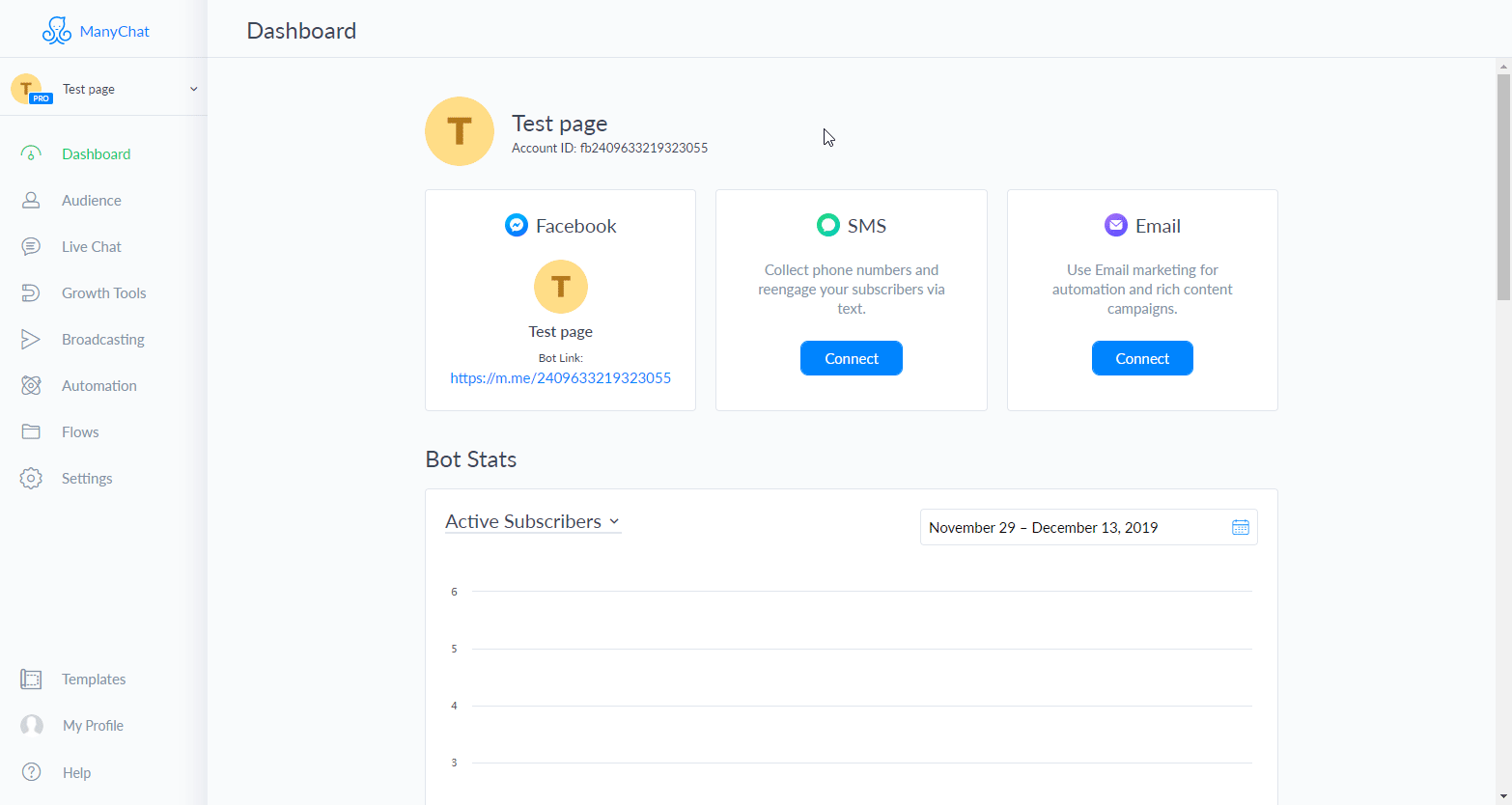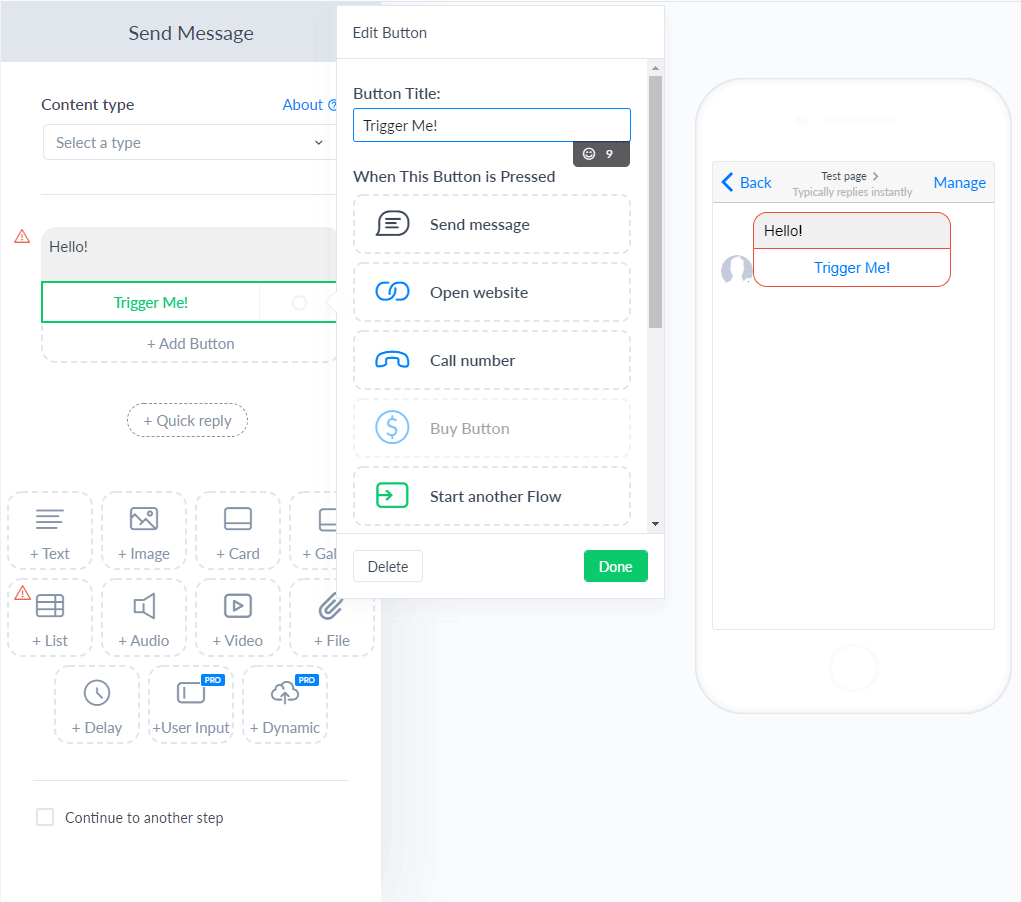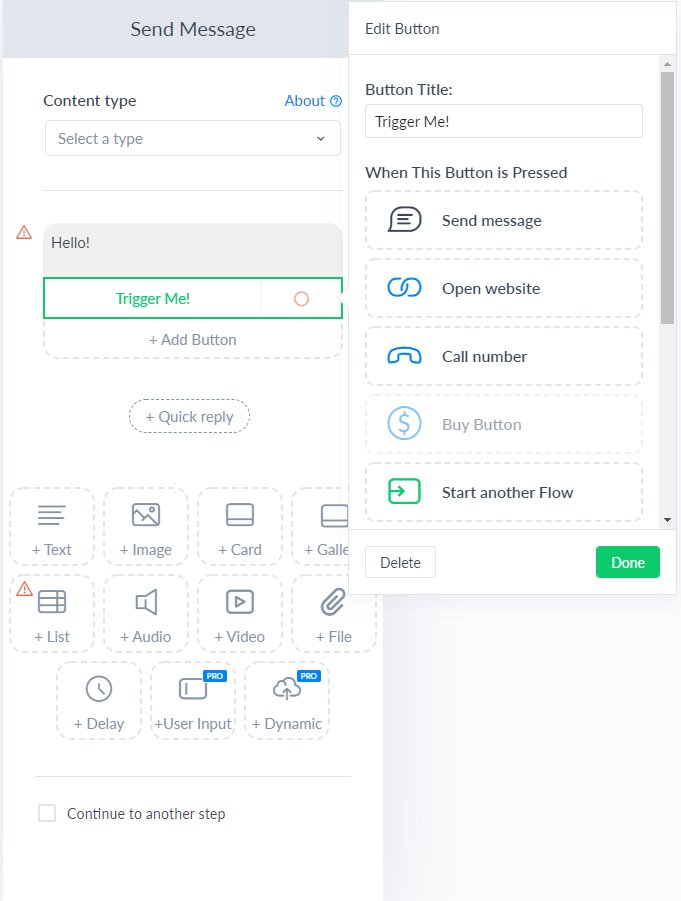| Active with remarks |
|---|
| This application needs additional settings. Please follow the documentation below to create your own connectionUnique, active service acces point to a network. There are different types of connections (API key, Oauth…). More. |
The Manychat modulesThe module is an application or tool within the Boost.space system. The entire system is built on this concept of modularity. (module - Contacts) More enable you to monitor new data, send messages, or flows and manage tags, custom fieldsA feature in Boost.space that allows you to define and manage data within each module according to your specific needs. More, or retrieve subscriber’s info in your Manychat account.
Prerequisites
-
A Manychat Pro account
In order to use Manychat with Boost.spaceCentralization and synchronization platform, where you can organize and manage your data. More IntegratorPart of the Boost.space system, where you can create your connections and automate your processes. More, it is necessary to have a Manychat account. If you do not have one, you can create a Manychat account at manychat.com.
![[Note]](https://docs.boost.space/wp-content/themes/bsdocs/docs-parser/HTML/css/image/note.png) |
Note |
|---|---|
|
The moduleThe module is an application or tool within the Boost.space system. The entire system is built on this concept of modularity. (module - Contacts) More dialog fields that are displayed in bold (in the Boost.space Integrator scenarioA specific connection between applications in which data can be transferred. Two types of scenarios: active/inactive. More, not in this documentation article) are mandatory! |
To connect your Manychat account to Boost.space Integrator you need to obtain the API TokenThe API token is a multi-digit code that allows a user to authenticate with cloud applications. More.
![[Note]](https://docs.boost.space/wp-content/themes/bsdocs/docs-parser/HTML/css/image/note.png) |
Note |
|---|---|
|
You need to have a ManyChat PRO account to generate the API TokenThe API token is a multi-digit code that allows a user to authenticate with cloud applications. More and connect Manychat to Boost.space Integrator. |
1. Log in to your Manychat account.
2. Go to Settings > API.
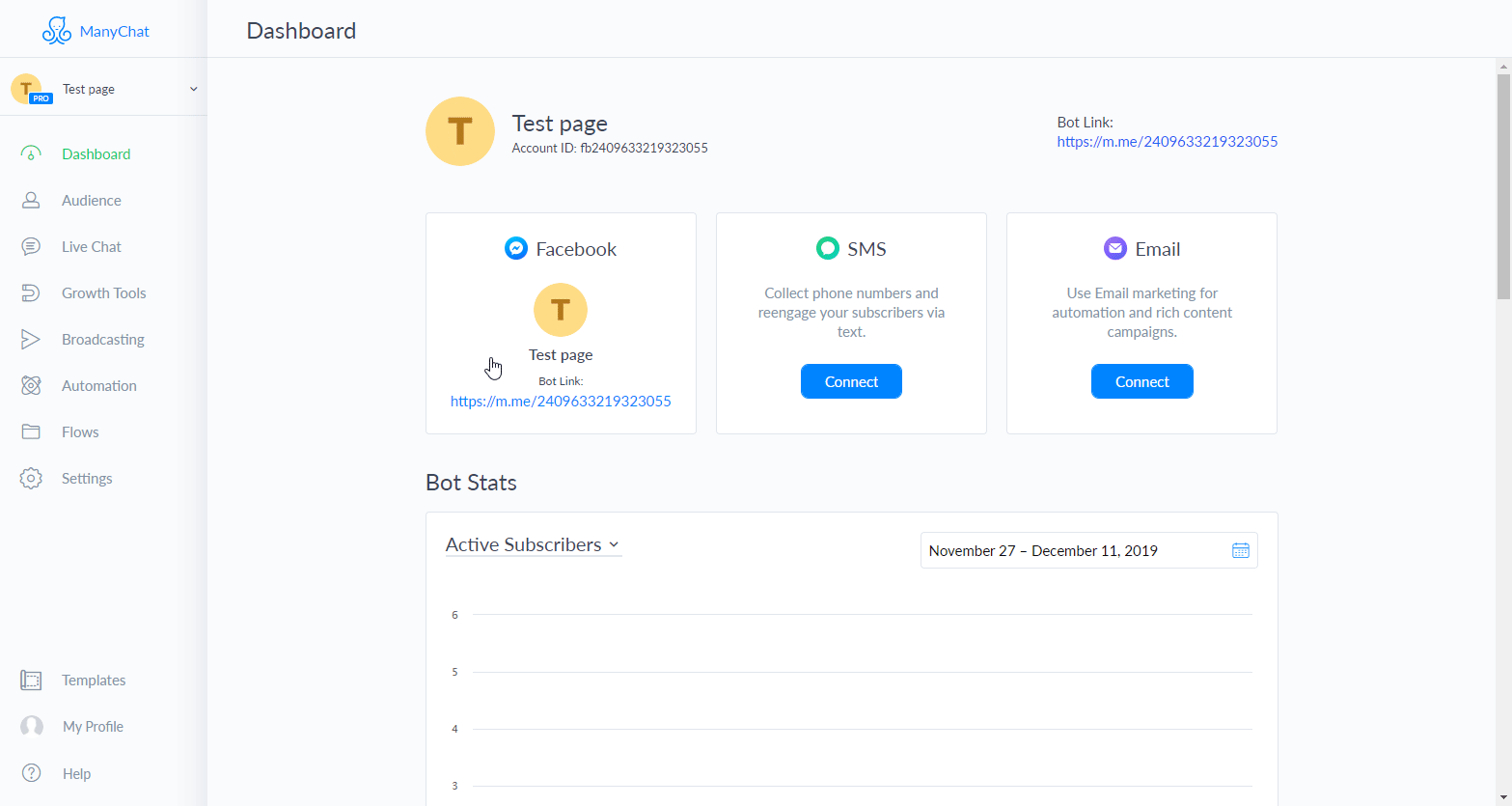
3. Click the Generate Your Token button.

4. Copy the provided token.

5. Go to Boost.space Integrator and open the ManyChat module’s Create a connection dialog.
6. Enter the API Token you have copied in step 4 to the respective field and click the Continue button to establish the connection.
TriggersEvery scenario has a trigger, an event that starts your scenario. A scenario must have a trigger. There can only be one trigger for each scenario. When you create a new scenario, the first module you choose is your trigger for that scenario. Create a trigger by clicking on the empty module of a newly created scenario or moving the... when a ManyChat action is performed and returns subscriber’s details. Add this module as the first module in your scenario.
|
WebhookA webhook is a way for an app to send real-time information to a specific URL in response to certain events or triggers. name |
Enter a name for the webhook. |
|
Connection |
To triggerEvery scenario has a trigger, an event that starts your scenario. A scenario must have a trigger. There can only be one trigger for each scenario. When you create a new scenario, the first module you choose is your trigger for that scenario. Create a trigger by clicking on the empty module of a newly created scenario or moving the... the Watch Incoming Data module you need to add an action to your ManyChat’s flow.
-
Log in to your ManyChat account.
-
Go to Flows and open the flow where you want to add the action that triggers the Watch Incoming Data module.
-
Add the Button or Quick reply. Click the +Add Button button and enter the Button Title.
-
Scroll down and click the +Action button.
-
Select the Trigger Boost.space Integrator option.
-
Click to the field below the TriggerBoost.space Integrator action and select the webhook that should be triggered when a userCan use the system on a limited basis based on the rights assigned by the admin. More clicks the button.
Now, when a user clicks the button, the Watch Incoming Data module in Boost.space Integrator is triggered.
Retrieves a subscriber’s details.
|
Connection |
|
|
Subscriber ID |
Enter (map) the Subscriber ID. |
Enables you to add or remove a tag from the subscriber.
|
Connection |
|
|
Subscriber ID |
Enter (map) the Subscriber ID. |
|
Action |
Select whether you want to add or remove a tag. |
|
Tag ID |
Select or map the tag you want to add or remove. |
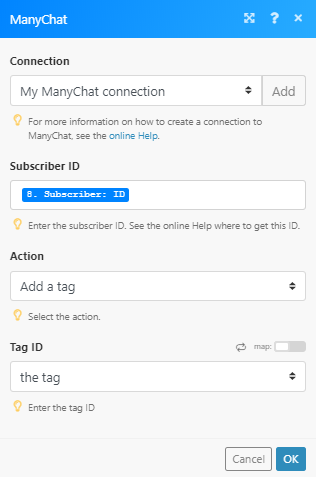
Performs one or more actions for the subscriber.
|
Connection |
||||
|
Subscriber ID |
Enter (map) the Subscriber ID. |
|||
|
Actions |
Add one or more actions you want to perform.
|
Sends a flow to the subscriber.
|
Connection |
|
|
Subscriber ID |
Enter (map) the subscriber ID to whom you want to send the flow. |
|
Flow ID |
Enter the flow ID of the flow you want to send to the subscriber. To use the Send a flowmodule, you need to get the unique ID of the flow you would like to send as shown below: 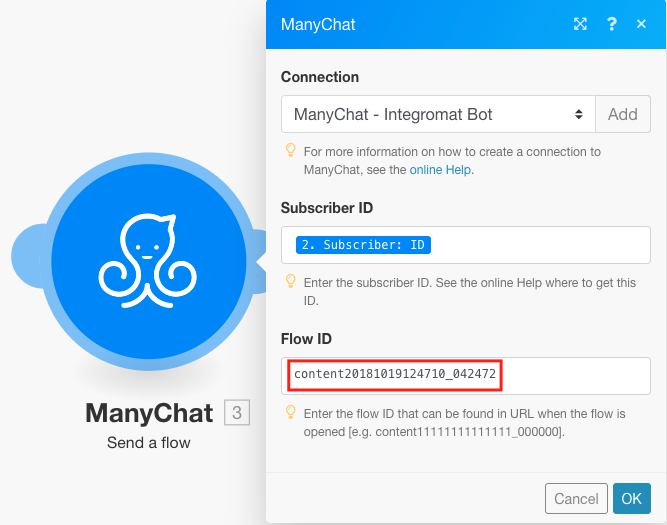 To get the Flow ID, go to Flows in your ManyChat account, select the flow and copy the ID from the page URL as shown below: 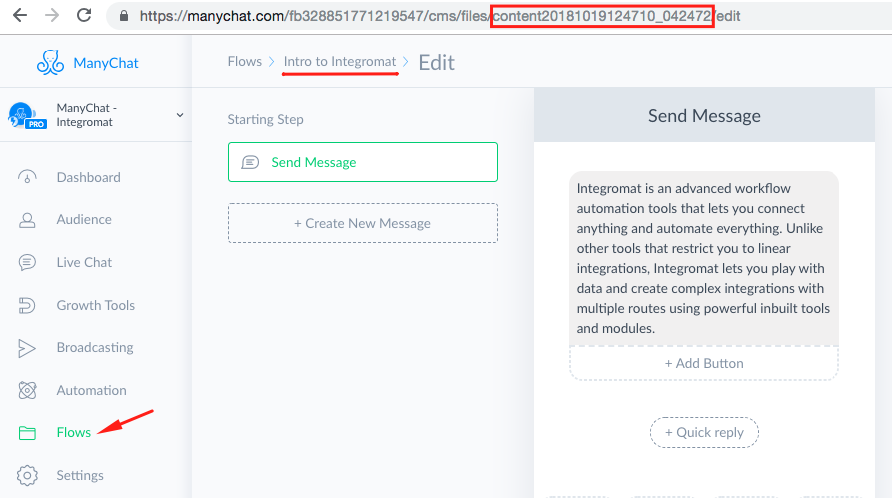 |
Enables you to send a batch of messages.
|
Connection |
|
|
Subscriber ID |
Enter (map) the Subscriber ID you want to send messages to. |
|
Message Tag |
Select one of the message tags. This is required from January 15th, 2020. |
|
Messages |
Add one or more messages. Required. Select the type of message to be sent to the subscriber and fill the corresponding fields. |
|
Quick Replies |
Add one or more quick replies. |
Sends a text message to the subscriber.
|
Connection |
|
|
Subscriber ID |
Enter (map) the subscriber ID you want to send a message to. |
|
Message Tag |
Select one of the message tags. This is required from January 15th, 2020. |
|
Text |
Enter the text content of the message. |
|
Buttons |
Add one or more buttons to the message. |
|
Quick Replies |
Add one or more quick replies. |
Sends a text message with the file to the subscriber.
|
Connection |
|
|
Subscriber ID |
Enter (map) the Subscriber ID you want to send the message to. |
|
Message Tag |
Select one of the message tags. This is required from January 15th, 2020. |
|
Text |
Enter the text content of the message. |
|
File URL |
Enter the URL of the file you want to attach to the message. |
|
File Type |
Select the file type of the file attached to the message. |
|
Quick Replies |
Add one or more quick replies. |
Sends a text message with the image to the subscriber.
|
Connection |
|
|
Subscriber ID |
Enter (map) the Subscriber ID you want to send the message to. |
|
Message Tag |
Select one of the message tags. This is required from January 15th, 2020. |
|
Text |
Enter the text content of the message. |
|
Image URL |
Enter the URL of the image you want to attach to the message. |
|
Buttons |
Add one or more buttons to the message. |
|
Quick Replies |
Add one or more quick replies. |
Sets the value of the custom field for the subscriber.
|
Connection |
|
|
Subscriber ID |
Enter (map) the Subscriber ID you want to set the custom field for. |
|
Field ID |
Select or map the custom field you want to add the value to. |
|
Field Value |
Enter the value for the custom field. |
Returns subscribers by a custom field.
![[Note]](https://docs.boost.space/wp-content/themes/bsdocs/docs-parser/HTML/css/image/note.png) |
Note |
|---|---|
|
The module works with the Text and Number custom field types only. |
|
Connection |
|
|
Field ID |
Select or map the custom field you want to search the subscriber by. |
|
Field Value |
Enter the value for the custom field you want to the subscriber by. |
|
Limit |
Set the maximum number of subscribers Boost.space Integrator will return during one execution cycleA cycle is the operation and commit/rollback phases of scenario execution. A scenario may have one or more cycles (one is the default).. |

